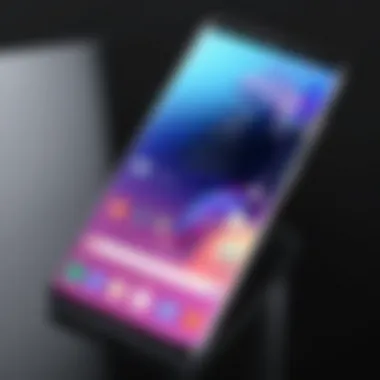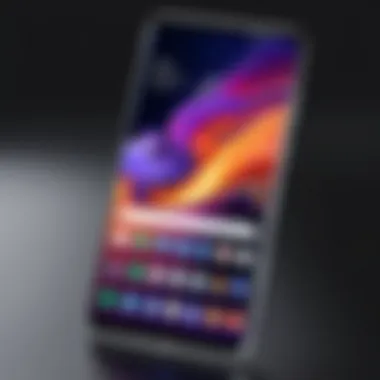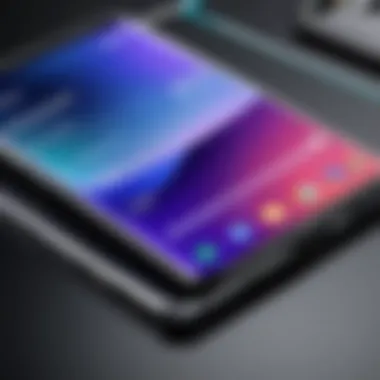Analyzing the Size Specifications of Galaxy S20


Intro
The Samsung Galaxy S20 has garnered significant attention since its release, particularly regarding its size and the implications this has for user experience. In the mobile device market, size specifications play a crucial role in determining performance, usability, and appeal. This article explores various dimensions of the Galaxy S20's physical characteristics and contextual relevance, ultimately providing an understanding of how size impacts device functionality.
Features Overview
Key Specifications
The Samsung Galaxy S20 features a sleek design with dimensions that make it both compact and functional. It measures 151.7 x 69.1 x 7.9 mm and weighs approximately 163 grams. Its display is 6.2 inches, making it one of the more manageable devices in the flagship segment. The dynamic AMOLED 2X display has a resolution of 3200 x 1440 pixels, ensuring crisp visuals that enhance interaction.
The device supports a refresh rate of up to 120 Hz, which significantly improves the fluidity of animations and responsiveness in various applications. Battery life is another aspect influenced by size; the S20 is equipped with a 4000 mAh battery that supports both wired and wireless charging.
Unique Selling Points
One of the standout features of the Samsung Galaxy S20 is its camera system. The triple rear camera setup includes a 12 MP ultra-wide lens, a 12 MP wide lens, and a 64 MP telephoto lens. This versatility allows users to capture high-quality images across a range of scenarios.
In addition to hardware specifications, the integration of software features like Adobe Lightroom can elevate the photography experience further. Additionally, the Galaxy S20’s design offers IP68 water and dust resistance, adding durability to its slick external appearance.
Performance Analysis
Benchmarking Results
Performance benchmarking is key to understanding the Galaxy S20's capabilities. Recent tests indicate that the device performs exceptionally well under various conditions. Using software like AnTuTu, the Galaxy S20 achieved impressive scores, often surpassing competitors in its class. The Snapdragon 865 processor, coupled with 8GB or 12GB of RAM, contributes to its robust performance.
Real-world Scenarios
In real-world usage, the Galaxy S20 excels in multitasking and gaming scenarios. Users report smooth performance when running multiple heavy applications or during intensive gaming sessions. The size of the screen enhances the gaming experience, providing ample space for controls and visuals. Moreover, the device's ergonomic design allows for extended use without excessive strain on the hands, which is a notable advantage for long durations of interaction.
The Samsung Galaxy S20 stands out in its segment not only for its size but also for how these dimensions enhance both the user experience and device performance.
This comprehensive examination aims to lay the groundwork for understanding the complexities of size in contemporary mobile technology. By evaluating features, performance, and user feedback, the importance of size in shaping device functionality becomes clear.
Preface to the Galaxy S20 Size
This segment explores the importance of the size specifications related to the Samsung Galaxy S20. Understandably, smartphone size impacts several factors such as usability, handling, performance, and design. As smartphones have become integral to daily life, the size of these devices has evolved into a crucial consideration among manufacturers and consumers alike.
Overview of the Galaxy S20
The Samsung Galaxy S20 occupies a significant place in the current smartphone market. Released in early 2020, it features a dynamic AMOLED screen measuring 6.2 inches diagonally. This size is a balance between facilitating a wide viewing experience while remaining convenient for hand-held use. The device’s cuttlefish design makes it visually appealing yet functional.
The Galaxy S20 also comes equipped with innovative technology, including a 120Hz refresh rate display. This enhancement not only improves visual fluidity but also ties back into size considerations. Larger screens generally provide richer detail, yet they can weigh down user experience if they become unwieldy. Therefore, the S20 attempts to merge these elements into a single device that caters to various user needs.
Significance of Size in Smartphones
The size of a smartphone plays several roles in user experience. Here are key considerations:
- Usability: A larger screen can allow easier navigation of apps and content. However, if the device is too large, it can become cumbersome, particularly during prolonged use.
- Portability: The dimensions of a phone can directly affect its portability. Dimensions must allow easy fitting into pockets or bags while not sacrificing functionality.
- Design Aesthetics: The way size complements the overall design can dictate market preference. Sleek and compact designs have become popular, influencing purchasing decisions.


Physical Dimensions of the Galaxy S20
Understanding the physical dimensions of the Galaxy S20 is essential for several reasons. First, specifications like height, width, and thickness directly impact how users interact with the device. Ease of use, portability, and overall user satisfaction hinge on the size of the smartphone. Second, in a competitive market, knowing these dimensions can help consumers make informed choices when selecting a device that best fits their needs and lifestyle.
Height, Width, and Thickness
The Samsung Galaxy S20 has specific measurements that define its physical footprint. It measures 151.7 mm in height, 69.1 mm in width, and has a thickness of 7.9 mm. These dimensions make the device relatively compact. This design aspect is particularly appealing to users who prefer smartphones that can fit comfortably in their hands or pockets.
A slimmer phone can also enhance aesthetics, aligning with contemporary design trends. An important consideration is the aspect ratio of the display, which is 20:9 on the Galaxy S20. This allows for a taller display, making it easier to view content while scrolling. However, a taller aspect ratio may affect one-handed use, as reaching the upper corners of the screen could be challenging for some users.
Weight Considerations
The weight of a device is yet another crucial factor. The Galaxy S20 weighs approximately 163 grams. For a smartphone of its size, this is relatively lightweight. Such weight allows for extended use without causing hand fatigue. Users often appreciate a lighter phone when carrying it throughout the day or using it for long durations.
However, weight can also influence the perception of build quality. Some consumers may equate heft with durability, thus preferring devices that feel more substantial in hand. This is a nuanced consideration; manufacturers must balance lightweight design with the expectation of sturdiness.
"Physical dimensions can often dictate the user experience. It's not just about fitting into a pocket, but how comfortably one can use the device day-to-day."
Overall, examining the physical dimensions of the Galaxy S20 reveals much about its usability and consumer appeal in a crowded market. Analyzing height, width, thickness, and weight allows potential buyers to gauge how well the device fits into their daily routines and preferences.
Galaxy S20 Size Comparison with Competitors
A comprehensive examination of the Samsung Galaxy S20 necessitates a thorough comparison with its contemporaries. This section explores the significance of size within the smartphone market, especially in relation to the Galaxy S20’s competitors. Size can directly influence user experience, functionality, and aesthetic appeal. Thus, understanding how the Galaxy S20 stacks up against similar devices is essential for potential buyers and enthusiasts.
Comparison with the Galaxy S20 Ultra
The Galaxy S20 Ultra stands as a significant rival within Samsung's own product lineup. At first glance, the S20 Ultra appears larger and boasts superior specifications. The dimensions of the Ultra, sitting at 167.9 x 76 x 8.8 mm, clearly distinguish it from the standard S20, which measures 151.7 x 69.1 x 7.9 mm. This size difference allows the Ultra to host a bigger battery and more advanced camera systems; however, it sacrifices some portability. Users who lean towards larger displays may find the Ultra more appealing, yet this size compromise can affect ease of handling for some.
In essence, while the S20 Ultra offers enhanced features, the standard S20 caters to those who prefer a more compact device without significant compromises in performance.
Comparative Analysis with iPhone Series
When comparing the Galaxy S20 against the iPhone series, particularly the iPhone 12 and 12 Pro, notable differences emerge. The iPhone 12 measures at 146.7 x 71.5 x 7.4 mm, resulting in a similarly sized product. However, the weight is a crucial factor: the S20 weighs 163 grams while the iPhone 12 is slightly lighter at 164 grams. This marginal difference in weight may not be particularly significant, however, the iPhone's flat edges contribute to a different tactile experience.
User reviews often emphasize the preference for certain handling characteristics, with many users finding the iPhone's size easy to grasp with one hand. In contrast, the S20's rounded edges provide a different grip, though some may find it less comfortable during prolonged usage. Therefore, each option brings its strengths and weaknesses in size behavior that influences usability.
Comparison with Leading Android Devices
In examining the Galaxy S20's size in relation to other leading Android devices, such as the OnePlus 8 and Google Pixel 5, some notable contrasts can be observed. The OnePlus 8 measures 160.2 x 72.9 x 8 mm, while the Google Pixel 5 comes in at a compact 144.7 x 70.4 x 8 mm. The Galaxy S20’s measurements place it between these two competitors, offering a balance for users who seek a middle ground in size.
In terms of usability, the Galaxy S20 holds an edge in terms of screen quality and overall performance compared to the Pixel 5. However, many users may prefer the Pixel's smaller and more manageable size for day-to-day tasks. This comparative analysis underscores how size continues to be a vital metric in assessing smartphone suitability for various user needs.
A deeper understanding of size helps consumers make more educated choices based on comfort and application requirements.
Through these comparisons, it becomes clear that while the Galaxy S20 boasts several competitive features, the size still plays a pivotal role in how users perceive functionality and utility across a variety of devices. Understanding these nuances aids in determining not only preferences but also practical use in real-world scenarios.
Impact of Size on User Experience


The size of a smartphone like the Galaxy S20 plays a critical role in shaping the user's interactions with the device. Understanding how size affects usability is vital in today’s market, where users seek devices that suit their needs. A focus on ergonomics, screen usability, and one-handed operation contributes to a fuller comprehension of user experience.
Ergonomics of the Galaxy S20
Ergonomics refers to the design of the device in relation to user comfort and efficiency. The Galaxy S20, with its dimensions of approximately 151.7 x 69.1 x 7.9 mm, has been crafted for a variety of hand sizes. This size leads to a comfortable grip and supports prolonged usage without significant strain. The weight of the device, around 163 grams, complements this ergonomic design, ensuring it feels sturdy yet not overly burdensome during day-to-day tasks.
Screen Real Estate and Usability
The Galaxy S20 boasts a 6.2-inch Dynamic AMOLED display. This screen size strikes a balance between compactness and functionality. Users can enjoy media, gaming, and browsing experiences without excessive scrolling. The resolution of 2400 x 1080 pixels ensures that images appear clear and vibrant. Adding to this, the edge-to-edge display enhances visual appeal and usability, creating a more immersive interaction. The meaningful screen space also benefits multitasking capabilities, which professional and tech-savvy users often require in their daily activities.
One-Handed Usage Considerations
One-handed operation is a crucial factor for many users. The Galaxy S20 was designed with this in mind. With its more compact dimensions, users find it easier to navigate applications and texts. However, while the size promotes one-handed usage, some features, like larger on-screen buttons, further enhance accessibility. Users can configure settings for better one-handed functionality, allowing a seamless experience in various scenarios, be it while commuting or multitasking at home.
"A device that can be comfortably managed with one hand can significantly enhance user satisfaction and productivity."
Technical Aspects Related to Size
The technical aspects relating to the size of the Galaxy S20 are foundational to understanding its overall performance and user experience. These elements influence everything from battery life to the internal organization of components. They also pose unique advantages and challenges that tech enthusiasts and IT professionals should carefully consider. The interplay between size and technology governs the device's efficiency and usability in practical scenarios.
Battery Capacity and Size Constraints
Battery capacity is one of the primary technical considerations when discussing device size. The Galaxy S20 features a 4,000 mAh battery, designed to fit within its compact form factor of 151.7 x 69.1 x 7.9 mm. The challenge lies in optimizing battery life without compromising the physical dimensions of the device. As the size of smartphones continues to decrease, manufacturers must devise innovative solutions for increasing battery efficiency.
- Higher energy density batteries are being developed to save space.
- Advanced power management software helps extend battery life.
- The S20’s screen resolution and refresh rate also significantly impact battery performance.
"Optimizing battery size within smartphone constraints is a continual challenge for manufacturers, impacting performance and user satisfaction."
Internal Component Arrangement
The internal layout of the Galaxy S20 reflects a sophisticated design that prioritizes both functionality and size. The arrangement of components, including the processor, RAM, and camera systems, is crucial to prevent overheating while maximizing performance. With its Exynos 990 or Snapdragon 865 chipset, the S20 places considerable demands on its internal architecture.
Key factors in this arrangement include:
- Space Optimization: Components are positioned to minimize area usage, making the phone sleek yet powerful.
- Heat Distribution: Efficient design allows for better heat dissipation, crucial for component longevity.
- Accessibility: By strategically placing connectors and ports, servicing and repairs can be more manageable.
Cooling Solutions and Size Impact
Cooling solutions play an essential role in maintaining the performance integrity of the Galaxy S20. As devices become more powerful while maintaining size constraints, effective thermal management is imperative.
- Vapor Chambers are often used in high-end devices like the S20 for superior cooling efficiency.
- Improved airflow design reduces thermal buildup during intensive tasks.
- Ensuring proper cooling is vital to prevent performance throttling which can occur when the device overheats.
Understanding these technical aspects not only enhances knowledge regarding the Galaxy S20 but also reflects broader trends in smartphone development. As technology evolves, the balance between size and performance will continue to be a crucial discussion point for users and manufacturers alike.
Case Studies on Galaxy S20 Usage
Case studies on the Galaxy S20 usage reveal the practical implications of its size and design in various real-world environments. By examining how different user demographics interact with the device, one gains valuable insights into its strengths and limitations. This section delves into specific elements that highlight the functionality of the Galaxy S20 as it is used in daily life and professional settings. Understanding these case studies helps illustrate how the dimensions of the Galaxy S20 affect user experience and satisfaction.


Real-World Use Cases
In typical usage scenarios, the Galaxy S20 proves itself versatile. Many users in urban environments appreciate its size for convenience. The compactness of the device allows easy storage in pockets and purses. Everyday tasks such as texting, browsing social media, and managing emails become simpler, thanks to the manageable size. Users often mention the comfort of holding the device for extended periods while watching videos or reading articles.
Some notable real-world use cases are as follows:
- Public Transport Commuters: These users benefit from the S20’s lightweight feel and thin profile, making it less cumbersome during commutes.
- Students: The size is suitable for quick note-taking and reading e-books, with the screen size optimized for these tasks.
- Casual Photographers: The S20’s camera capabilities enhance the appeal to users who might not carry heavier gear.
Professional Usage Scenarios
When it comes to professional contexts, the Galaxy S20 often finds its way into business operations. It supports efficiency by accommodating diverse workflows. Its size is adequate for running productivity apps and managing communication, making it a preferred choice for professionals in fast-paced environments.
Key professional uses include:
- Fieldwork: Professionals in construction or landscaping value the S20 for its portability and performance, capturing project progress without lugging around heavier equipment.
- Remote Workers: Employees who work from home rely on the S20 for video conferencing and stay connected with clients on the go.
- Creative Services: Designers and content creators utilize its camera and editing capabilities for quick content production while traveling.
By providing insight into real-world and professional scenarios, these case studies showcase the adaptability of the Galaxy S20. The implications of size specifications go beyond numbers, deeply influencing usability and user perceptions in everyday life.
Consumer Feedback on Galaxy S20 Size
Understanding consumer feedback regarding the size of the Samsung Galaxy S20 is essential for several reasons. First, user experiences often illustrate how size impacts usability and satisfaction. Size plays a pivotal role in performance, particularly when it comes to handling, portability, and display clarity. As smartphones become integral to everyday life, recording and analyzing feedback provides insight into user preferences and expectations. Examining consumer opinions on the Galaxy S20's dimensions can also inform future design considerations by manufacturers.
Survey Results on Preference
A comprehensive survey conducted with Galaxy S20 users revealed significant preferences regarding size. The following points summarize the findings:
- Ideal Dimensions: Many users reported a preference for a device that easily fits in their hands and pockets. The Galaxy S20, with its height of 151.7 mm, width of 69.1 mm, and thickness of 7.9 mm, was favored for its balance between screen size and portability.
- Display Impact: Some survey respondents emphasized importance of display size, noting that they appreciate the 6.2-inch Dynamic AMOLED screen for media consumption, despite concerns about one-handed operation.
- Weight Sensitivity: Weight also influenced preferences, with the S20’s weight of 163 grams being viewed as manageable, leading to comfort in prolonged use.
- Versatility in Use Cases: Users expressed that the size positively affects various applications, such as gaming and productivity tasks, enabling a more immersive experience.
These survey results illustrate a collective desire for functionality within the context of convenience, which the Galaxy S20 largely satisfies.
User Reviews and Testimonials
User reviews of the Galaxy S20 provide further qualitative insights into the perceptions of size and usability. The feedback can be categorized as follows:
- Positive Feedback: Many users praised the sleek design and manageable dimensions of the S20. They reported that it was less cumbersome than larger models, allowing for easy one-handed navigation.
- Mixed Reactions on Screen Size: While some appreciated the vibrant display, others expressed concerns that larger screens may lead to inadvertently touching various buttons or sections on the interface.
- Feedback on Comfort during Daily Use: Users highlighted a preference for the grip offered by the device’s form factor, stating it feels natural during active use and texting.
- A Note on Build Quality: Some reviewers articulated that the material quality, despite its size, yields an aesthetic and tactile satisfaction that enhances their overall experience.
In summary, the Galaxy S20's size has generated a range of feedback, reflecting a notable balance of functionality, comfort, and user preference. As manufacturers analyze this data, it becomes clear that understanding consumer feedback is crucial for ongoing development and innovation in smartphone design.
End
Understanding the size specifications of the Samsung Galaxy S20 is crucial for a variety of reasons that extend beyond mere numbers. The significance of this topic lies in its direct relation to user experience, performance, and the broader landscape of smartphone design. By analyzing aspects like ergonomics, usability, and the implications for future models, we gain insight into how size impacts not just the device itself, but also the way we interact with technology.
Summary of Key Insights
This article has highlighted several key aspects regarding the Galaxy S20's size.
- Physical Dimensions: The height, width, and thickness of the Galaxy S20 are designed to strike a balance between portability and screen size.
- User Experience: The ergonomic considerations ensure comfortable usage. The larger display enhances engagement but also poses challenges for one-handed operation.
- Comparative Analysis: Comparing the Galaxy S20 with its competitors shows its position in the market. It stands out for its design and user-centric features, offering a compelling case for users looking for a premium device.
- Feedback Insights: Consumer feedback reveals a range of preferences, emphasizing the importance of understanding user sentiment regarding size.
In summary, the Galaxy S20's size specifications have implications for design philosophy and user interaction that cannot be overlooked.
Future Implications for Smartphone Design
The insights derived from the Galaxy S20's design can inform future smartphone trends. As users increasingly demand devices that are both powerful and easy to handle, manufacturers may need to innovate around size and ergonomics.
- Size Customization: Future devices might offer customizable size features to suit individual user preferences, allowing for a more tailored user experience.
- Enhanced Usability: Design approaches will likely focus on improving one-handed usability without sacrificing screen real estate, creating devices that are as functional as they are comfortable.
- Integration of Technology: As technology advances, the integration of larger displays with compact designs may become more feasible, influencing the aesthetic and functional elements of future smartphones.



